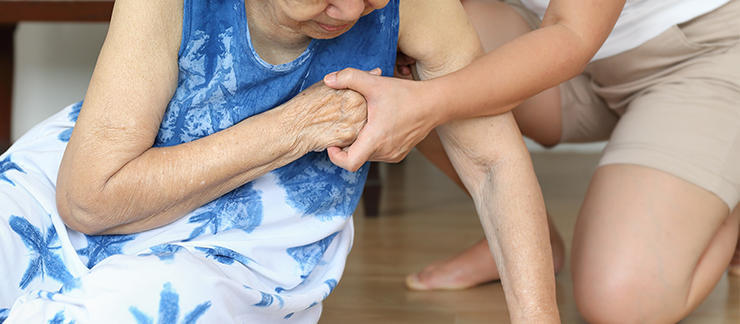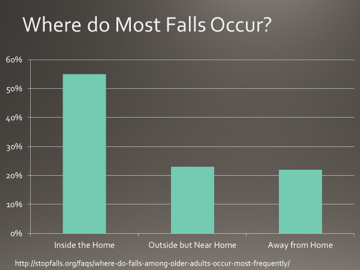
Fall Prevention Strategies and Tips for Aging Seniors
Your parents are getting older and slower. Balance and vision may start to become an issue in walking. Unfortunately, many seniors don’t realize that they can’t perform activities in the same way anymore. A sudden movement to reach for something or leaning on a wall to climb the stairs can cause an unanticipated fall.
Falls by maturing adults are serious events. Many are life changing that dramatically affect the quality of life of an aging adult. According to the Centers for Disease Control and Prevention, falls are the leading cause of fatal injury and non-fatal, trauma-related hospital admissions among older adults. Every year, one in every four seniors falls. And one of every five falls causes a serious injury such as a broken bone or head injury. Senior fall prevention is important to reduce the occurrence of a fall and injury to your maturing loved one.
What Causes a Fall?
Physical and environmental factors contribute to falls. As adults mature, balance disorders, medical conditions, vision problems, physical weakness, and slower gaits heighten the risk of falls. Seniors can fall when climbing stairs, turning too quickly, slipping on stairs, and holding onto unstable furniture when maneuvering around the home.
Home hazards including poor lighting, lack of stair railings, and clutter add to fall risk. Unsafe use of equipment such as walkers and canes and wearing floppy shoes and loose clothing also increases the prospect of an accident. The more risk factors a person faces, the greater their chances of falling and getting injured.

Physical Injuries Due to A Fall
The Centers for Disease Control and Prevention reports that more than 95% of hip fractures are caused by falling. Recovery is slow, taking weeks or even longer to recover. Half will never recover to their prior level of function. Often, many sufferers won’t be able to visit the bathroom, get into bed, or climb the stairs without assistance.
For some, a hip fracture can be a death sentence. Of the 300,000 Americans over 65 who suffer a hip fracture each year, 20 to 30% will die within a year or experience significant loss in body functionality. It is not the break itself, but the body’s response to it that causes the mortality.
In addition to hip fractures, falls can result in:
- Arm, ankle, rib and other fractures
- Head injury
- Pain and disability
- Placement in a rehabilitation facility
Emotional Impact of Falls
Once falling, seniors often are afraid to fall again and avoid leaving the house. As a result, many cut back on activities and social events. Isolated in their homes, seniors become lonely, sad, and depressed. Depression and anxiety can increase the risk of falling, creating a pattern of fear that negatively impacts an aging adult’s independence and emotional state.
Others may form bad habits such as holding onto furniture or walls to maintain their balance or looking down at the floor to prevent tripping. These new behaviors contribute to falls instead of preventing them.
Seniors experiencing a fall may even delay important routine activities such as going to the bathroom, taking a shower, or drinking water that can lead to problems. For example, delaying a trip to the bathroom can cause a urinary tract infection while ignoring signs of thirst can cause dehydration. Sitting for long periods due to inactivity weakens muscles that can add to the risk of future falls.

Steps to Fall Prevention
Research demonstrates that seniors can avoid falls by decreasing risks. The following senior fall prevention tips can lessen the chance of a debilitating accident.
- Visit the Doctor and Ask Questions
Doctors can conduct a thorough patient evaluation to determine potential risks for falling. Tell your physician about any falls, near falls, or unsteadiness of your aging loved one. Ask about medications that can cause dizziness or sleepiness. Discuss the need for additional examinations such as hearing or podiatry and discuss fall prevention strategies.
- Make Lifestyle Changes
Start or increase physical activity to improve muscle strength and balance as well as mood and socialization. Incorporate activities that improve strength, balance, flexibility, and endurance. Inactive adults should start slow. Walking, gardening and swimming are popular activities among older adults. Yoga is great to build balance that can help prevent falls.
Lifting light weights or using resistance bands can build muscle strength. Seniors can even exercise while seated lifting their legs or light weights. Begin with short intervals of moderate activity for 5 – 10 minutes and build time and endurance. Always check with your physician before starting or changing exercise routines. For additional senior fall prevention exercise tips, refer to the National Institute on Aging.
- Assess the Home for Modifications
The home itself can pose different hazards that lead to falls. Assess the home or ask for advice from an experienced home healthcare agency to determine positive changes in the home. Some needed modifications may include adding:
- Grab bars to sides of tub/shower and next to the toilet
- Railings on stairways
- Non-skid tub mats and handheld shower heads
- Reflective tape strips to edge of staircase
- Night lights in dark spots or rooms frequented during the night such as the bathroom
- Flashlight near bed
Remove any clutter blocking pathways and place frequently used items such as books, lamp, and telephone on a bedside table. Store clothes, food items, dishes and essentials in lower drawers and shelves for easier reach. Should a senior need a cane or walker, a physical or occupational therapist should train them on safely using them.
Preventing a fall often means the difference between your aging parent living in the comfort of their home or moving into a nursing home. Understanding risk factors and implementing fall prevention strategies are key to avoiding falls. Ask for advice on senior fall prevention from your doctor or a home care agency. Visiting Angels can implement a senior fall prevention program to help reduce risk factors based on an individual’s health condition and needs.
